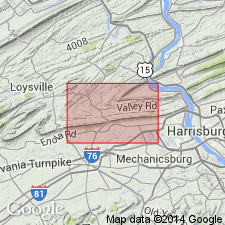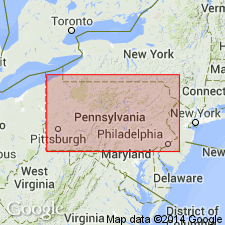
- Usage in publication:
-
- Sherman Creek Member
- Modifications:
-
- Named
- Dominant lithology:
-
- Sandstone
- Shale
- Siltstone
- AAPG geologic province:
-
- Appalachian basin
Summary:
Sherman Creek Member of Catskill Formation named in southeastern PA. Described as grayish-red to brownish-red shales, siltstones, and fine-grained sandstones with some gray fine-grained sandstone interbeds. Thickness 3,500 ft. No complete section available as type section. Type area designated. Overlies Irish Valley Member and underlies Clarks Ferry Member. Age is Late Devonian.
Source: GNU records (USGS DDS-6; Reston GNULEX).

- Usage in publication:
-
- Sherman Creek Member
- Modifications:
-
- Overview
- AAPG geologic province:
-
- Appalachian basin
Summary:
Author's purpose is to describe in detail the sedimentology of the Sherman Creek, Clarks Ferry and Duncannon Members of the upper part of the Catskill Formation as seen in three outcrops along Rte 322 in south-central PA. Outcrops are at Second Mountain, Peters Mountain, and Buffalo Mountain. All three members are composed of sandstone bodies and sandstone-mudstone interbeds and are recognized in part on the basis of the varying ratios of the two lithofacies associations. The Sherman Creek and Duncannon Members are composed of approximately equal amounts of sandstone and mudstone in the study area, while the Clarks Ferry is dominated by sandstone and is not as widespread. These three members are assigned to the alluvial plain depositional environment. At Second Mountain, Sherman Creek is 167 m thick and is 50 percent sandstone. At Peters Mountain, unit decreases in thickness to 100 m and sandstone content increases to 60 percent. Unit is not mapped at Buffalo Mountain where the Duncannon Member composes the entire 85 m of Catskill Formation.
Source: GNU records (USGS DDS-6; Reston GNULEX).
For more information, please contact Nancy Stamm, Geologic Names Committee Secretary.
Asterisk (*) indicates published by U.S. Geological Survey authors.
"No current usage" (†) implies that a name has been abandoned or has fallen into disuse. Former usage and, if known, replacement name given in parentheses ( ).
Slash (/) indicates name conflicts with nomenclatural guidelines (CSN, 1933; ACSN, 1961, 1970; NACSN, 1983, 2005, 2021). May be explained within brackets ([ ]).

